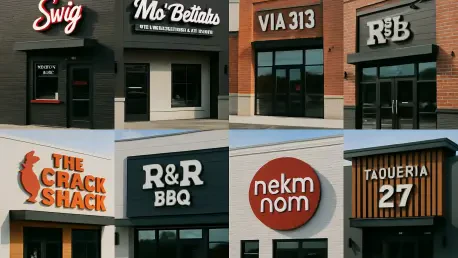In an era where the restaurant industry faces relentless competition, with over 1 million establishments vying for consumer dollars in the United States, standing out requires more than just a good menu. The ability to scale unique dining concepts while maintaining authenticity has become a defining factor for success. Amid this challenging landscape, four brands under the Savory Fund portfolio—Houston TX Hot Chicken, Via 313, Mo’ Bettahs Hawaiian Style Food, and South Block—have secured coveted spots on the Inc. 5000 list, a hallmark of rapid growth among private companies. This achievement not only underscores their individual market traction but also signals broader trends in consumer preferences and investment strategies. The following analysis delves into the dynamics behind their rankings, exploring what this means for the restaurant sector and how strategic partnerships are reshaping growth trajectories.
Market Trends and DatWhat Drives Savory Fund’s Portfolio Growth?
Niche Concepts Capturing Consumer Appetite
The restaurant market has seen a notable shift toward specialized dining experiences, with consumers increasingly gravitating toward brands that offer distinct flavors and cultural authenticity. Houston TX Hot Chicken, ranked at No. 217 on the Inc. 5000 list, exemplifies this trend with its fiery, niche comfort food, expanding to 29 locations across seven states. This rapid growth reflects a broader demand for bold, hyper-focused concepts that resonate emotionally with diners. Data suggests that niche food categories, particularly those tied to regional or cultural identities, are outpacing generic fast-casual growth by nearly 15% annually, highlighting an opportunity for brands to carve out loyal customer bases in a saturated market.
Regional Expansion and Scalability Challenges
Examining the geographic spread of Savory Fund’s brands reveals critical insights into scalability. Via 313, with its Detroit-style pizza at No. 2050, operates 25 locations in three states, while Mo’ Bettahs Hawaiian Style Food, ranked No. 2868, boasts 66 locations across seven states with its authentic plate lunches. These figures point to a strategic focus on multi-state expansion, leveraging diverse markets to build brand recognition. However, scaling culturally specific cuisines often faces hurdles like supply chain constraints for unique ingredients and the risk of diluting authenticity. Market analysis indicates that successful brands mitigate these issues through robust operational frameworks, often supported by investment partners who streamline logistics and distribution.
Health-Driven Segments and Competitive Pressures
South Block, securing No. 4829 on the list with 20 Mid-Atlantic locations, taps into the burgeoning health-conscious segment, offering acai bowls and smoothies to a wellness-focused demographic. This niche has seen a compound annual growth rate of 8% over recent years, driven by rising consumer interest in dietary health. Yet, the segment is not without challenges, as national chains intensify competition and regional concentration can limit broader market penetration. Differentiators like sustainable packaging or innovative menu items could provide an edge, aligning with consumer values around environmental responsibility and transparency in nutritional content.
Strategic Investment: The Role of Savory Fund in Market Success
Capital and Expertise Fueling Expansion
A deeper look into the success of these brands reveals the pivotal role of Savory Fund, a private equity firm managing over $750 million in assets. By partnering with emerging restaurant concepts, the firm provides not only financial backing but also operational expertise through shared services platforms. This model has enabled brands to scale without sacrificing their unique identities, a balance that many independent operators struggle to achieve. Industry reports suggest that private equity involvement in the restaurant sector has grown by 20% since 2025, reflecting a trend where strategic investment is becoming a cornerstone of competitive growth.
Portfolio Diversity as a Risk Mitigation Strategy
Savory Fund’s portfolio, which includes other notable names like Swig and R&R BBQ, showcases a deliberate strategy of diversification across culinary styles and market segments. This approach mitigates risk by spreading exposure across varying consumer trends, from comfort food to health-focused offerings. The inclusion of four distinct brands on the Inc. 5000 list highlights the effectiveness of this tactic, as it captures multiple growth drivers within the industry. Market observers note that diversified portfolios are better positioned to weather economic fluctuations, such as rising operational costs, which have impacted nearly 60% of independent restaurants since 2025.
Adapting to Economic and Technological Shifts
Beyond diversification, Savory Fund’s success also ties into its adaptability to broader economic and technological trends. With inflation and labor costs posing persistent challenges, the firm’s emphasis on efficiency through technology—such as AI-driven customer analytics and optimized delivery systems—has proven vital. Projections indicate that restaurant brands integrating digital tools for operations and marketing could see revenue uplifts of up to 12% by 2027. This forward-thinking approach positions Savory Fund’s brands to maintain growth momentum, even as market conditions evolve with potential regulatory changes around labor and food safety.
Future Projections: Navigating the Evolving Restaurant Landscape
Consumer Trends Shaping Demand
Looking ahead, consumer demand for unique dining experiences is expected to intensify, with forecasts suggesting that culturally resonant and health-focused concepts will drive a significant portion of industry growth through 2027. Brands like those in Savory Fund’s portfolio are well-placed to capitalize on this, provided they continue to innovate in menu offerings and customer engagement. Emerging trends, such as the rise of plant-based options and experiential dining, could further expand market opportunities for niche players willing to adapt.
Technological Integration as a Growth Lever
Technology will likely remain a critical factor in sustaining competitive advantage. Advanced data analytics for personalized marketing and streamlined delivery logistics are projected to become standard for scaling brands. For Savory Fund’s portfolio, investing in these areas could enhance operational efficiency and customer retention, potentially boosting market share by 10% over the next two years. The challenge lies in balancing tech adoption with the human touch that defines many of these brands’ appeal, a delicate equilibrium that will shape their long-term viability.
Regulatory and Economic Uncertainties
Market projections also highlight potential headwinds, including regulatory shifts around labor laws and food safety standards that could increase operational costs. Economic pressures, such as fluctuating consumer spending power, may further test resilience. Brands under Savory Fund’s umbrella will need to prioritize flexibility in their expansion strategies, possibly focusing on smaller-format locations or hybrid models to manage costs. Industry analysis suggests that firms with strong financial backing and operational agility are 30% more likely to navigate such uncertainties successfully.
Reflecting on Success: Strategic Pathways Forward
Looking back, the recognition of Houston TX Hot Chicken, Via 313, Mo’ Bettahs Hawaiian Style Food, and South Block on the Inc. 5000 list marked a defining moment for Savory Fund, showcasing the potency of strategic investment in driving restaurant growth. Their achievements illuminated the power of niche branding and diversified portfolios in a fiercely competitive market. Moving forward, stakeholders in the industry should consider prioritizing partnerships that offer both capital and operational support to scale unique concepts effectively. Additionally, investing in technology to enhance customer insights and streamline operations emerged as a non-negotiable for sustained expansion. As the restaurant landscape continues to shift, adaptability and a keen focus on emerging consumer values stand out as essential strategies for any brand aiming to replicate this success.









